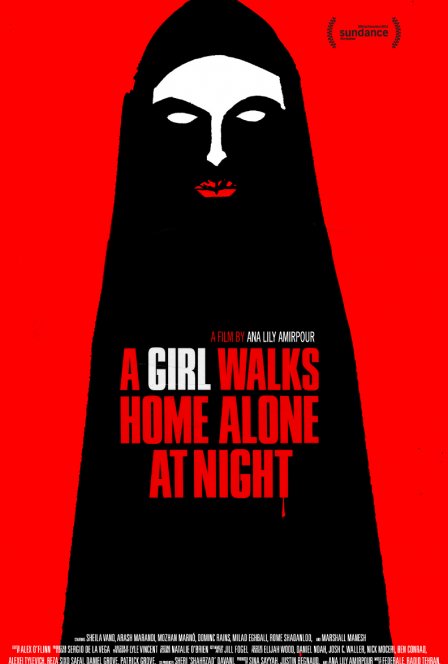What happens to girls who walk home alone at night? Usually, bad things. But as with many elements of A Girl Walks Home Alone At Night, the title of Ana Lily Amirpour’s film riffs on or upends our expectations. Her Iranian vampire spaghetti western is both a gleeful pop homage and its own bizarre creation.
Amirpour was born in England but raised in Florida and California, and this kaleidoscopic sense of place (and self) is mirrored in her film. For the setting, Amirpour reimagines the ennui of the California desert as the fictional Bad City where the Iranian characters speak Farsi. Resisting attempts to saddle the film with political intent, Amirpour is adamant that Bad City is not Iran but its own “fairy tale world.” This is not a dodge: though her creative choices cast shadows, ultimately Amirpour’s film is ruled by aesthetics. She isn’t shy about quoting her sources, but it’s more like she’s crazy in love with her inspirations. This is especially apparent in the music, from the Iranian rock of Radio Tehran and Kiosk, to the spaghetti western sound of Federale, the post-punk White Lies, and the Armenian remixes of Bei Ru. The songs are chosen with such precision and love that they occasionally overpower the film. These are all good things. It’s a beautiful film to watch, its swooning, moody vignettes enhanced by the black-and-white, anamorphic cinematography full of lens flares and racked focus. Amirpour has confidence in her choices, and there’s a pleasure in seeing her world realized. Even if the film is somewhat thin on story and occasionally drifts, her vision never wavers.
The film is built less on plot than on its characters. There is of course a girl, The Girl (the luminous Sheila Vand), a wide-eyed gamine who dances shyly in her room and who is also a vampire who stalks the streets of Bad City at night. She is somewhat ambivalent about her condition, cruising down shadowy streets on a skateboard and cloaked in a chador. She seems to have a moral code, feeding on the “bad” people of Bad City, her hunger meting out a crude kind of justice. The boy, the pretty Arash (Arash Marandi), is a 1950s throwback who wears fitted white t-shirts and denim and drives a vintage Ford Thunderbird. There’s an additional chain of side characters, though I honestly found them less compelling. Arash is chained to his father, a heroin addict in debt to a gangster. But mostly the film tracks The Girl and Arash, inevitably bringing them together. Arash is on his way home from a costume party dressed as Dracula when he encounters The Girl. She lures him home to her lair, but rather than overpower him she surrenders to him. The slow-motion seduction, perfectly choreographed to White Lies’ “Death,” is the film’s most moving scene.
The seduction stands out because Amirpour’s film lingers on the surface. A Girl Walks Home Alone At Night is a cool piece of work, driven by the look rather than the feel. In interviews Amirpour shouts out David Lynch, Sergio Leone, and Rumble Fish, but claims she is “not very much into Jarmusch,” which I find surprising. I can see Wild At Heart, but more than anything Girl made me think of Down By Law or Mystery Train. I applaud Amirpour for bucking the trend of chasing reality in favor of inventing her own. There is something really refreshing about this kind of artfully constructed world that feels cinematic. Part dream, part pop love story, wholly unique to its creator.

